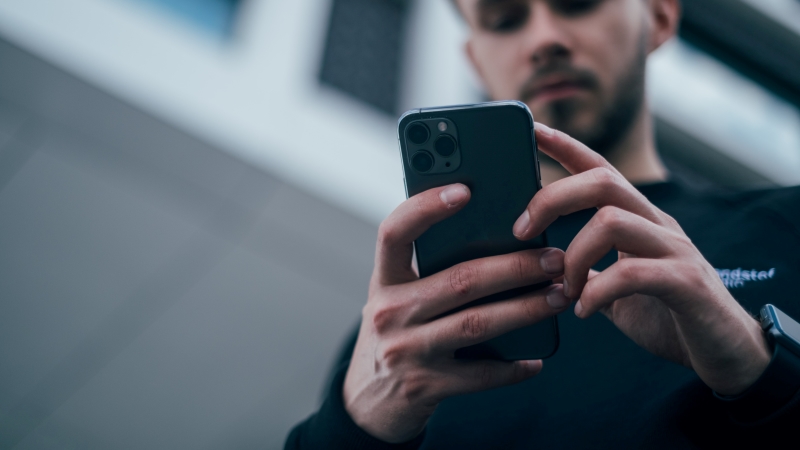Face ID, iris scanners and Co. are so secure.
Smartphones have become constant companions. The protection of our devices and data is therefore playing an increasingly important role. We now use biometric screen locks for this, among other things. But how secure are Face ID, iris scanner and fingerprint sensor really?
Whether in everyday life, at work or on vacation: Most people always have their smartphone with them. It is used for communication, reminds you of appointments and to-do lists and is also a place to store documents and photos.
The smartphone is also often used as a means of payment. However, since mobile phones contain different data and access, protection against unauthorized access is particularly important.
Contents
Protection for smartphones: Biometric screen locks are extremely popular
For a long time, smartphones were only protected from use by third parties by a pin. But now there are far more options for the data protection.
Especially the biometric screen lock is considered to be extremely popular these days. Face recognition, fingerprint sensor and iris scanner are typical. But what are the advantages of the individual access blocks? And how safe are you?
Face recognition privacy
Face recognition is a popular way to quickly and easily unlock your smartphone. With a glance at the screen, users can access their device in seconds. In terms of security, however, there are serious differences between the various operating systems.
Android face recognition has flaws
Android face recognition, for example, has significant defects on. This is mainly due to the fact that many smartphone manufacturers only use the front camera to check the face.
This hardware solution is so simple that scammers can easily trick it. A photo is often enough to outwit face recognition. And because of social media, they’re often easy to get.
Apple’s Face ID is considered particularly secure
In general, face recognition from Apple is considered particularly safe methodto protect the smartphone. Because Face ID doesn’t just rely on the selfie camera to identify the user’s face.
Instead, iPhones contain an infrared camera that takes a corresponding picture. So, when setting up, the face is scanned and captured by about 30,000 infrared rays.
A height profile is also created, which in turn is converted into a 3D image and a height map. This depth information makes it practically impossible to trick the protection system with just a simple photo.
In the past, only a few scientists from Vietnam managed to outsmart Face ID using an elaborately manufactured mask made of stone powder. And that’s only because the researchers assembled them from 3D printed parts and 2D photos. They also had to position the mask at a very specific angle to the camera.
Data protection: lock for smartphones via iris scanner
The iris scanner was first used in the Galaxy S8 in 2017. The method is based on the fact that the human iris is unique in each person. It should therefore theoretically only be possible for a specific person to unlock their smartphone using the iris scanner.
Chaos Computer Club hacks Galaxy S8 iris scanner
He showed that this calculation does not quite add up Chaos Computer Club (CCC) just a few months after the roll-out of the new device. The hackers managed to outsmart the system using infrared photos and contact lenses.
Samsung countered that it was unlikely for a third party to get a high-resolution photo of a person taken with an infrared camera. However, the internet offers numerous instructions.
The CCC does not recommend this type of data protection. When the Galaxy S8 iris scanner was hacked, the most expensive part was buying the smartphone itself.
Apple plans to add iris scanners to headsets
rumours According to Apple wants to build the iris scanner in its new headsets. As two people apparently involved in the development announced, users of the device should be able to log into their respective accounts faster using an iris scan. The method should help above all when different users use the same headset.
Protection for smartphones: the fingerprint sensor
The fingerprint sensor was first used on the iPhone 5s in the form of Touch ID. With this method, too, the developers used the uniqueness of the human fingerprint as a basis.
Nowadays, the fingerprint sensor is part of every smartphone. It is often enough for owners to lightly touch their device with the previously scanned finger.
Fingerprints on other devices are used to replicate
Although the fingerprint sensor is generally considered secure, it can system Reportedly relatively easy to outsmart. Mainly because most people leave their fingerprints on other objects as well.
According to research by cybersecurity firm Cisco Talos, criminals can easily use these molds to create 3D plastic replicas. in the test the success rate of the experts was 80 percent.
And the fact that the fingerprint sensor only scans part of the finger is also a problem. This is because the entire fingerprint is not saved when the method is set up. And only when it is fully present is it truly unique. Otherwise, partial prints may well match those of other people.
There is no such thing as a 100% secure lock for smartphones
However, developers are constantly working on new ways in which data protection can work even better on mobile devices. For example, researchers in France have invented a new system that will allow users to unlock their smartphones with a heartbeat. All you have to do is hold your phone in your hand.
But it doesn’t matter whether it’s face recognition, an iris scanner or a fingerprint sensor: there is no such thing as a 100% secure smartphone lock. As the winner in the race for the safest method, Apple is way ahead with Face ID.
Also interesting:



